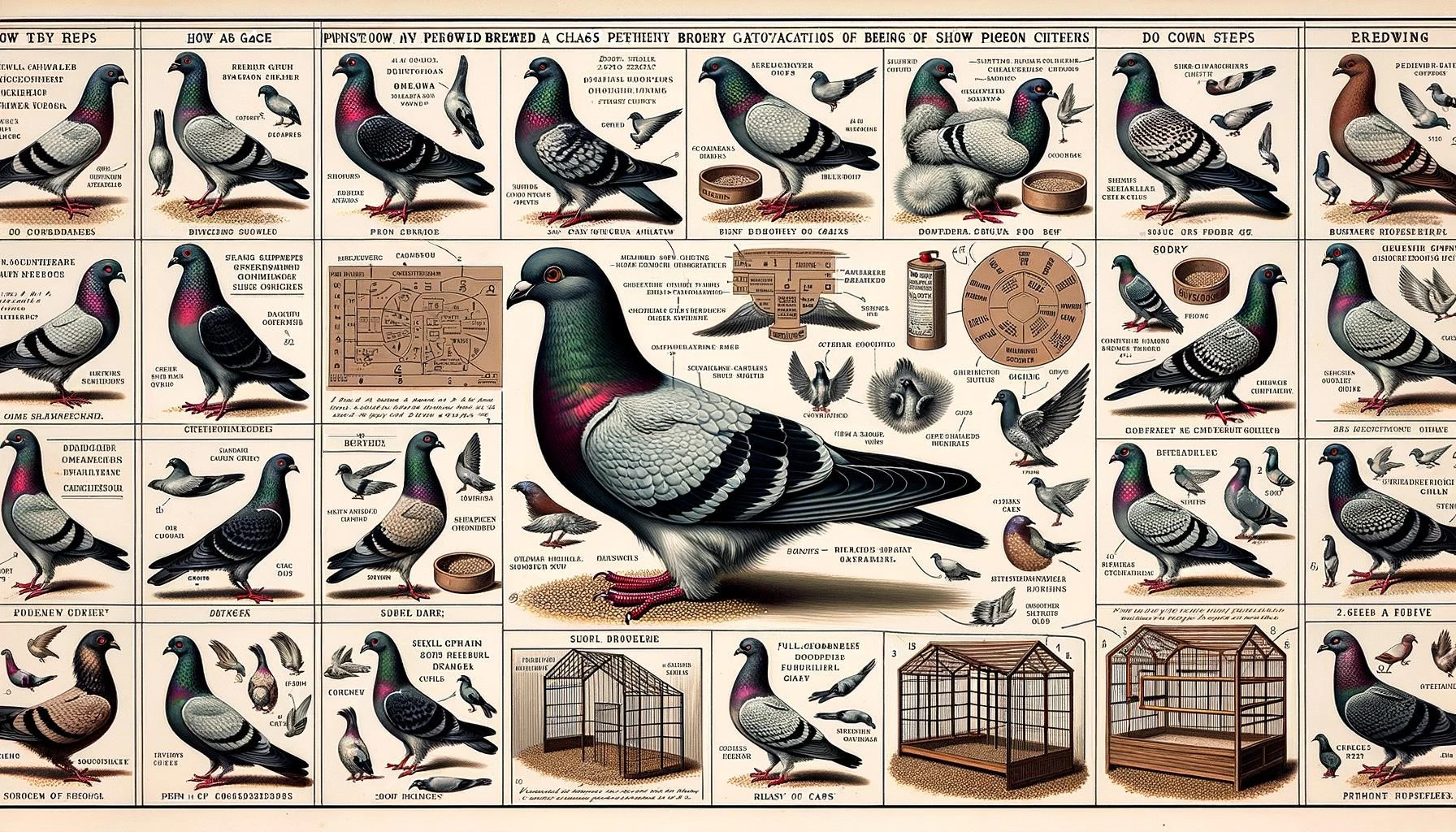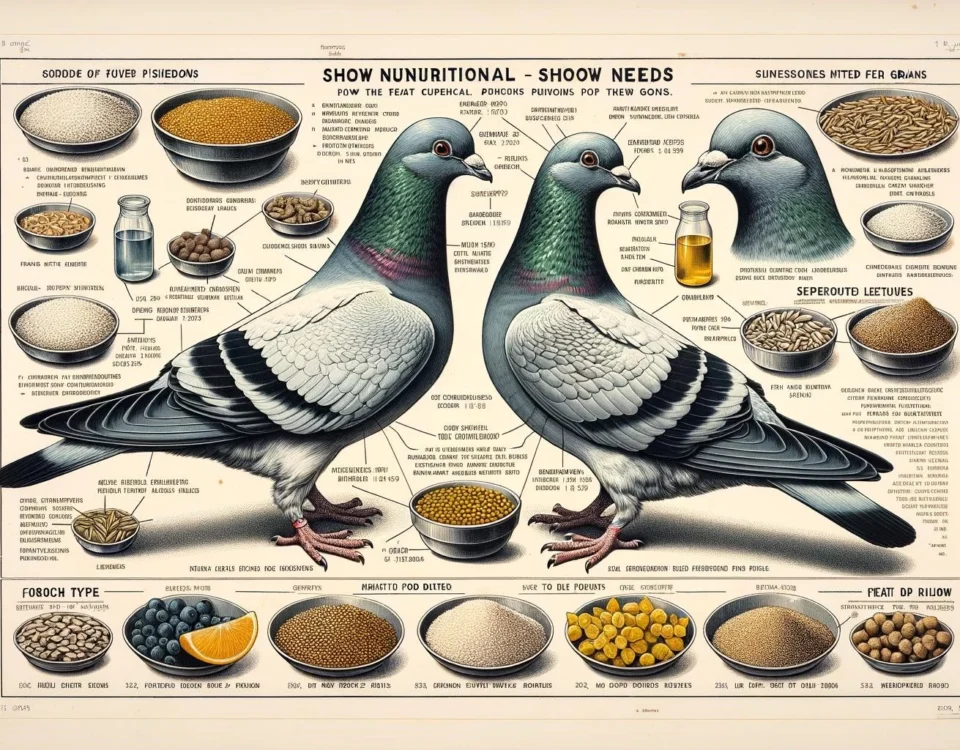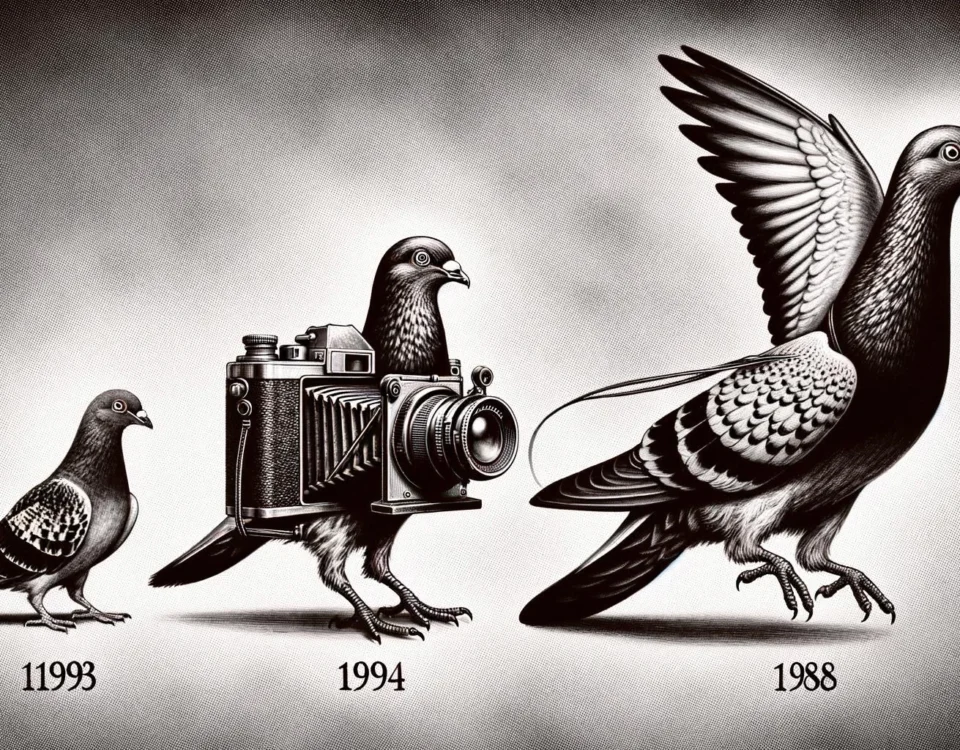Introduction to Breeding Show Pigeons
Breeding show pigeons requires meticulous steps to develop birds that excel in exhibitions. Breeders begin by selecting pairs with desirable traits such as excellent feather qualityideal body shape, and attractive color patterns—essential features for competition success.
Once the perfect pairs are chosen, maintaining optimal living conditions becomes crucial. A clean, spacious loft ensures the pigeons remain healthy. Equally important is providing proper nutrition, which supports both the parent birds and their chicks in staying strong.
Dedicated pigeon enthusiasts often keep comprehensive records of lineage and performance. These logs are invaluable for identifying successful genetic combinations and ensuring that preferred traits are sustained or enhanced over time. Techniques like selective breeding can further hone specific attributes.
Keeping an eye on health is also a critical aspect of breeding show pigeons. Regular health checks help prevent illnesses, while a balanced diet enhances overall vitality. Knowledge of pigeon genetics enables breeders to make informed decisions when pairing birds to produce exceptional offspring for competitions.
In essence, breeding show pigeons involves thoughtful pair selection, attentive care practices, nutritious diets, and detailed record-keeping to create high-quality birds ready for exhibitions.
Understanding Show Pigeon Breeds and Qualities
Understanding the diverse breeds of show pigeons and their unique characteristics is essential for breeders. Each type boasts distinct attributes that attract enthusiasts, such as unique plumage designs, body structures, and flying abilities. Familiarity with these features enables breeders to select the ideal pigeons for breeding programs focused on producing competitive exhibition birds.
Exhibition standards vary among breeds but generally emphasize aspects like feather texture, vibrant coloration, and symmetry. Breeders must adhere to these criteria to ensure their pigeons perform well in shows. Recognizing desirable traits across different pigeon breeds helps in choosing pairs that can pass these qualities on to future generations.
- jacobin, famous for its unique feathered hood around the head,
- fantail, noted for its distinctive fan-shaped tail,
- modena, admired for its compact build and striking plumage.
Understanding what sets each breed apart allows breeders to preserve or improve these traits through selective breeding.
Overall, a thorough knowledge of show pigeon breeds and their characteristics not only fosters successful breeding but also helps maintain high standards at pigeon exhibitions globally.
Popular Show Pigeon Breeds
Fan Tails, Frill Backs, Croppers, and Dragons are among the favored breeds in pigeon shows, each distinguished by its unique characteristics.
- fan tails captivate with their elegant, fan-shaped tails,
- frill backs are notable for their distinctive curled feathers,
- croppers draw attention with their prominent, inflated crops,
- dragons impress with their robust bodies and vibrant colors.
For breeders aiming for success in global pigeon competitions, understanding these traits is crucial. Germany holds a pivotal place in the pigeon world and is often regarded as its “Mecca.” Here, prestigious events featuring thousands of pigeons highlight the significance of these breeds within fancy pigeon communities.
Physical Attributes and Desired Traits
In the world of show pigeons, certain traits are essential for triumphing in competitions. These birds should exhibit a well-proportioned appearance, with muscular, medium-sized bodies reminiscent of athletes. A sturdy bone structure is crucial to support their dynamic form. Additionally, soft feathers play a vital role as they improve both the bird’s looks and buoyancy.
Vitality is another critical attribute; pigeons need ample energy and endurance to excel during shows. Breeders often select birds with symmetrical features because symmetry enhances visual appeal while aligning with exhibition standards. A strong back contributes to the ideal physique, providing balance and stability in motion.
Color patterns can also have a significant influence on judging outcomes. While not essential for every breed, vivid and distinct plumage can captivate judges and audience members alike. By prioritizing these characteristics, breeders boost their chances of raising outstanding show pigeons prepared to compete worldwide.
Show Quality and Exhibition Standards
To breed show pigeons that meet the high standards of quality and exhibition, breeders must adhere to guidelines established by pigeon fancier organizations. These criteria focus on enhancing physical traits through selective breeding efforts. It’s essential for breeders to grasp these requirements, emphasizing aspects such as:
- feather quality,
- body symmetry,
- color patterns.
Pigeons are evaluated based on their adherence to specific breed standards, which vary among different types. For example, Modenas are expected to have a compact build, whereas Fantails should display a distinct tail shape. Judges look for birds that closely align with these ideal attributes.
Breeders strive to meet these standards by pairing pigeons that exhibit the desired qualities. They meticulously record lineage to ensure favorable traits persist in future generations. By carefully selecting mates, breeders aim to improve any deficiencies in their birds.
Maintaining high health standards is also vital for show-quality pigeons. A balanced diet and a clean environment significantly influence a bird’s condition and its readiness for competitions. By concentrating on these elements, breeders can produce pigeons that not only meet but often surpass global exhibition expectations.
Preparing for the Breeding Season
Getting ready for the breeding season with show pigeons requires careful planning. Start by selecting pairs that are both healthy and genetically compatible, as this significantly influences the quality of their chicks.
- ensure they have an ideal setting,
- a clean, roomy loft not only promotes health but also enhances reproductive success,
- providing a nutritious diet rich in essential nutrients supports their overall well-being and boosts fertility.
Keep a watchful eye during incubation, monitoring the eggs and parent birds closely. This attentiveness allows you to address any problems swiftly, improving hatching success rates. Regular health checks are crucial to prevent diseases from impacting breeding.
- maintaining detailed records of lineage and previous outcomes can refine breeding strategies over time,
- by tracking this information, breeders can identify genetic pairings that enhance desired traits in future generations.
By focusing on pair selection, creating a conducive environment, ensuring proper nutrition, and vigilant health supervision, breeders set the stage for a prosperous season. This comprehensive approach results in top-notch show pigeons ready for competition.
Condition of Parents and Reproductive Capacity
The condition of parent pigeons plays a crucial role in their reproductive success and the vitality of their chicks. Yearling pigeons, being younger, often produce higher-quality offspring compared to their older counterparts. This advantage is largely due to their ability to produce superior crop milk, which is vital for the development of young birds.
Ensuring that parent pigeons remain healthy is essential for optimal breeding outcomes. To enhance reproductive performance, it is important to:
- provide balanced nutrition,
- maintain a clean habitat,
- perform regular health evaluations.
Breeders aiming for exceptional young birds focus on these factors to achieve superior breeding results.
Pairing Pigeons: Finding the Right Match
Selecting the ideal pigeons for breeding is essential. It’s important to take into account both their temperament and compatibility to prevent issues like fighting or bullying. Observing their initial interactions can reveal potential problems, allowing you to make adjustments if necessary. Successful pairs often possess complementary traits that enhance desirable qualities in their offspring, such as excellent feathering and body shape. By focusing on harmonious behavior and physical attributes, breeders boost the likelihood of producing winning show pigeons with each breeding cycle.
Breeding Program: Planning and Execution
The triumph of a breeding program hinges on meticulous planning and execution. Breeders ought to start with a clear vision of the champion pigeons they aim to produce. Establishing specific objectives, like enhancing certain traits or adhering to exhibition standards, sets the stage for effective breeding.
Maintaining comprehensive records is vital. By documenting each phase of the breeding process, breeders can monitor progress and pinpoint successful genetic pairings. This data-driven strategy enables them to make well-informed decisions about future matches, ensuring consistent improvement in their birds.
Execution involves selecting pairs based on preferred traits and providing optimal living conditions. A pristine environment supports health and enhances reproductive success. Nutrition plays a crucial role too; a diet abundant in essential nutrients boosts vitality and fertility for both parents and their offspring.
Diligent monitoring throughout the breeding process is necessary to promptly address any issues, thereby improving hatching success rates. Regular health evaluations of parent birds further contribute to positive outcomes.
Ultimately, a thoughtfully planned breeding program emphasizes:
- goal-setting,
- meticulous record-keeping,
- optimal care environments,
- balanced nutrition,
- vigilant oversight to cultivate high-quality show pigeons prepared for competition.
Effective Breeding Techniques for Show Pigeons
Effective breeding strategies for show pigeons encompass selective breedingline breeding, and outcrossing, each offering distinct benefits tailored to the breeder’s goals and the birds’ attributes.
- selective breeding pairs pigeons exhibiting specific desirable traits,
- this technique focuses on enhancing qualities such as feather texture, body symmetry, and color patterns,
- by matching birds with complementary features, breeders aim to produce offspring that stand out in competitions.
Line breeding involves mating closely related pigeons to retain exceptional traits within a lineage. This approach ensures consistency in preferred characteristics across generations but demands careful oversight to prevent genetic issues.
Outcrossing brings genetic diversity by combining different line-bred families. The goal is to achieve hybrid vigor, boosting resilience and overall health. This method helps address potential inbreeding problems while preserving key exhibition traits.
Selective Breeding for Performance and Appearance
Selective breeding is crucial for enhancing show pigeons, improving both their performance and appearance. Breeders select birds based on looks, lineage, and past achievements to refine features such as feather qualitysymmetry, and body structure.
To identify the best candidates for breeding, performance testing evaluates pigeons’ training and racing abilities. Those that excel are chosen to pass their outstanding traits to future generations, emphasizing the high standards required in competitions.
Keeping detailed records of lineage and successful genetic pairings is vital for selective breeding. This documentation enables breeders to make informed decisions, progressively improving pigeon traits over time.
Ultimately, selective breeding strives to elevate the aesthetic appeal and functionality of show pigeons by concentrating on traits that meet competitive benchmarks.
Line Breeding: Preserving Exceptional Traits
Line breeding is a technique employed to retain exceptional traits in show pigeons by concentrating on preserving a high proportion of genes from one or two standout birds. This method involves mating pigeons that are closely related, such as half-siblings, to ensure the consistent appearance of desirable characteristics in successive generations. The aim is to establish a lineage that exhibits qualities like excellent feather texture, balanced body structure, and striking color patterns.
Despite its benefits in maintaining these favorable attributes, line breeding requires careful oversight. Excessive genetic uniformity can lead to decreased vitality. To address this issue, breeders may conduct performance testing and occasionally introduce new genetic material from unrelated pigeons through outcrossing. This practice enhances hybrid vigor, thereby improving health and resilience.
When executed with precision, breeders can develop show pigeons that consistently exhibit winning traits while remaining robust. This approach not only preserves remarkable features within the lineage but also enhances success at pigeon exhibitions.
Out Crossing: Achieving Hybrid Vigour
Outcrossing is a breeding technique aimed at enhancing hybrid vigor in show pigeons. Breeders achieve this by mating line-bred pigeons with those that are unrelated, thereby introducing genetic diversity. This approach not only enhances the health and capabilities of the offspring but also mitigates inbreeding issues. Additionally, it fortifies essential traits for competitions, producing robust and resilient birds.
Health and Care of Show Pigeons
Caring for the health and well-being of show pigeons involves several essential practices. To keep them robust and disease-resistant, a balanced diet packed with vital nutrients is necessary. These birds thrive on a mix of grains, seeds, legumes, along with vitamins and minerals. Equally important is maintaining loft hygiene; a spotless environment minimizes the risk of bacterial or parasitic infections. Consistent cleaning and good ventilation are key to preventing disease outbreaks.
Health programs customized for different life stages significantly boost pigeon welfare. For instance, pre-breeding evaluations ensure that birds are fit for reproduction. Throughout the breeding season, it’s crucial to provide both parents and chicks with adequate nutrition and observation.
Moreover, managing stress during show season is critical as it impacts performance. Regular veterinary visits can help spot potential problems early on, enabling prompt action. These holistic care strategies are vital in ensuring the success of breeding show pigeons by keeping them healthy throughout their lives.
Importance of Nutrition and Natural Diet
A nutritious and natural diet is crucial for maintaining the health of show pigeons. By providing a balanced mix of grains, seeds, and legumes, along with essential vitamins and minerals, these birds stay energetic and perform admirably. Fresh water and appropriate supplements further enhance their well-being.
Incorporating natural ingredients not only aids digestion but also boosts immunity. Nutrient-dense foods play a significant role in helping young pigeons grow robustly while keeping adult birds in peak condition. Regularly reviewing their diet ensures all nutritional requirements are satisfied, allowing adjustments as they progress through various life stages.
Ultimately, prioritizing good nutrition through natural feeding practices is fundamental to sustaining pigeon health and enhancing the performance of breeding stock.
Preventing Illness Through Loft Hygiene
Ensuring a clean loft is vital to keep show pigeons healthy and free from illness. A well-maintained environment significantly reduces the likelihood of disease due to unsanitary conditions. Routine cleaning plays a key role in managing pests such as rodents and insects, which are common sources of contamination.
Effective sanitation involves:
- daily waste removal,
- regular disinfection of surfaces,
- maintaining good airflow to minimize moisture that can encourage bacterial growth.
By prioritizing hygiene, breeders enhance their pigeons’ resistance to diseases. This becomes particularly crucial during breeding seasons and when young birds are developing, as they are more susceptible at these times. Taking preventive measures not only aids in preserving pigeon health but also enhances their performance in competitions.
Common Health Problems and Disease Resistance
Respiratory illnesses pose a serious threat to show pigeons, often arising from bacteria and fungi lurking in their surroundings. Conducting regular health assessments can catch these issues early. Ensuring good ventilation in the lofts is essential, as it helps lower moisture levels that might cause infections.
Diseases caused by bacteria, such as salmonella, can be particularly devastating if pigeons’ water or feed becomes tainted. Maintaining a clean loft and providing fresh supplies are effective strategies to ward off these ailments.
Nutritional deficiencies present another danger, as they weaken a bird’s immune defenses, leaving it more susceptible to illness. A balanced diet filled with grains, seeds, vitamins, and minerals significantly enhances disease resistance and boosts the overall vigor of pigeons.
By emphasizing these preventive strategies, breeders can significantly improve their pigeons’ health and bolster their ability to fend off common diseases.
Health Programmes: Pre-Breeding, Breeding, and Show Season
The well-being of show pigeons is crucial throughout their lives, starting before breeding and extending through the show season.
The Pre-Breeding Health Program gets pigeons ready for reproduction by:
- conducting comprehensive health evaluations,
- adjusting their diet to enhance fertility.
Once breeding begins, maintaining the parents’ health with a nutrient-rich diet is essential. This not only promotes successful reproduction but also ensures that chicks receive adequate care and nourishment during their formative weeks.
When it comes to the Show Season Health Program, managing stress is paramount since competitions can affect how pigeons perform. Regular check-ups with a veterinarian are vital to:
- monitor their health,
- address any issues promptly.
Altogether, these programs ensure that show pigeons remain in peak condition, prepared to excel in competitions.
Challenges and Solutions in Breeding Show Pigeons
Breeding show pigeons presents various challenges, notably in maintaining health and genetic diversity. Avoiding inbreeding is essential, as it can compromise immunity and lead to genetic issues. To combat this, breeders are encouraged to introduce fresh bloodlines through outcrossing, which boosts hybrid vigor.
Managing the health of these birds is also a significant hurdle. Pigeons are susceptible to diseases, particularly when housed closely together. Therefore, keeping the loft clean is crucial. Regular health assessments and a nutritious diet contribute significantly to their well-being.
Environmental factors play a role in breeding success too. Fluctuations in temperature and humidity can pose difficulties, but ensuring stable conditions within the loft helps reduce these risks.
Financial investment cannot be overlooked either. Raising high-quality show pigeons demands resources for proper nutrition, suitable housing, and healthcare. Understanding the unique needs of each breed enhances competition results. By planning carefully and providing attentive care, breeders increase their chances of raising successful exhibition birds.
Dealing with Inbred Individuals and Genetic Diversity
Managing inbred pigeons involves implementing thoughtful strategies to mitigate the drawbacks of restricted genetic variation. Inbreeding can lead to health challenges and performance issues due to an increased likelihood of genetic disorders. However, breeders have ways to address these concerns by enhancing genetic diversity through specific approaches.
- one effective strategy is outcrossing, which introduces new bloodlines by mating unrelated pigeons,
- this practice encourages hybrid vigor, enhancing vitality and resilience, thus improving overall health outcomes,
- maintaining comprehensive records of lineage and health histories is crucial for identifying any risks associated with inbreeding.
Additionally, closely observing the health of inbred pigeons enables early detection of potential problems. Ensuring a balanced diet rich in essential nutrients also contributes to their well-being by strengthening immune systems.
By following these practices, breeders can tackle the challenges presented by inbred birds while fostering robust genetic diversity within their breeding programs.
Introducing Vital Outcrosses to Improve Stock
Introducing vital outcrosses is a strategic approach to enhance the performance of breeding stock in show pigeons. By incorporating birds from varied genetic backgrounds, breeders can significantly increase genetic diversity. This diversity plays an essential role in maintaining the health and vitality of their flocks by mitigating the risks associated with inbreeding, such as reduced immunity and poorer performance.
When selecting suitable outcrosses, it’s important to ensure compatibility between different lines while preserving key traits needed for exhibitions. New genetics can lead to hybrid vigor, resulting in offspring that exhibit improved resilience and overall health. This strategy not only fortifies the existing stock but also elevates qualities like feather quality and body structure.
In practice, breeders should maintain detailed records of genetic pairings to monitor progress and outcomes effectively. These records are invaluable for identifying successful combinations that align with breeding objectives. Ultimately, incorporating outcrosses into breeding strategies fosters a robust pigeon population that excels in competitive exhibitions.
Handling Physical Faults and Improving Breeding Value
To tackle physical defects in show pigeons, a strategic plan is vital. Spotting these imperfections early on can significantly boost their breeding potential. Breeders might want to consider bringing in birds with outstanding qualities. This not only injects fresh traits but also helps mitigate existing problems.
- regularly switch up pairings,
- mix genetic combinations,
- keep thorough records of previous breeding results.
By mixing genetic combinations, breeders can diminish recurring faults and foster desirable features across generations. Keeping thorough records of previous breeding results provides valuable insights into what works and what needs tweaking.
Sometimes, selective culling may be required if certain issues persistently appear. This ensures that only pigeons with the best attributes are chosen for future breeding efforts. By integrating these practices, breeders can ultimately improve the quality and exhibition appeal of their show pigeons.









